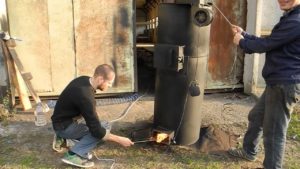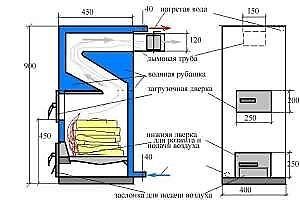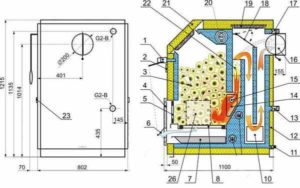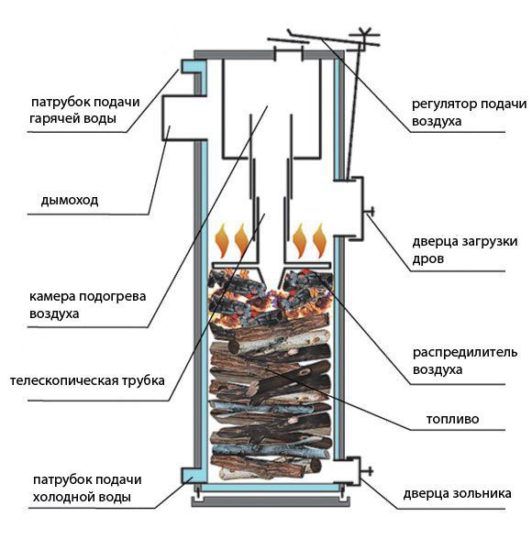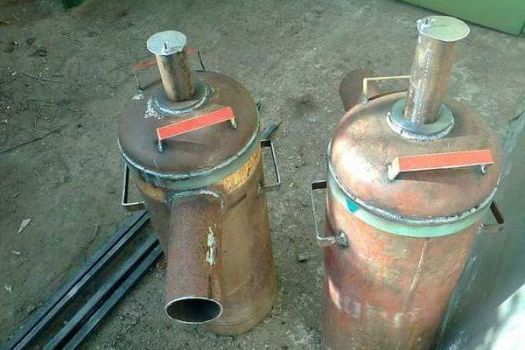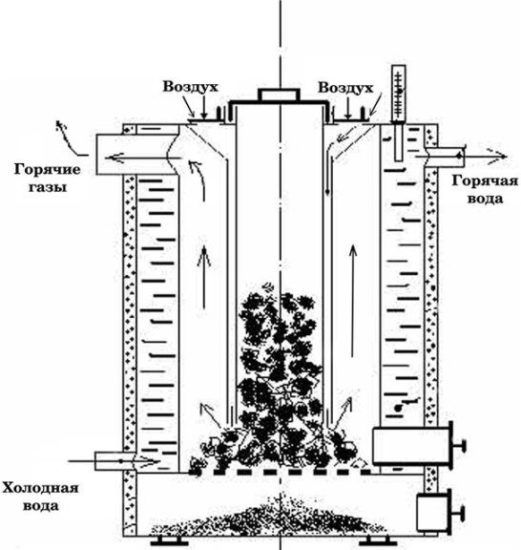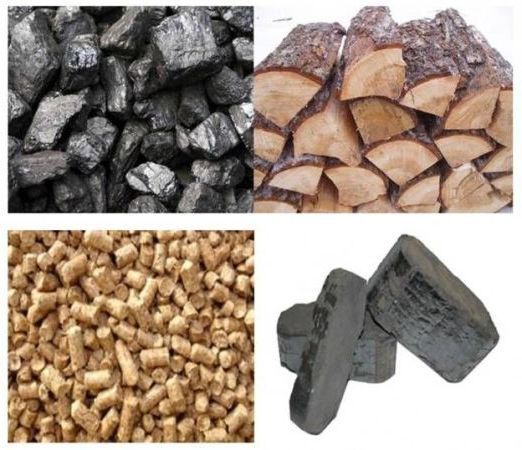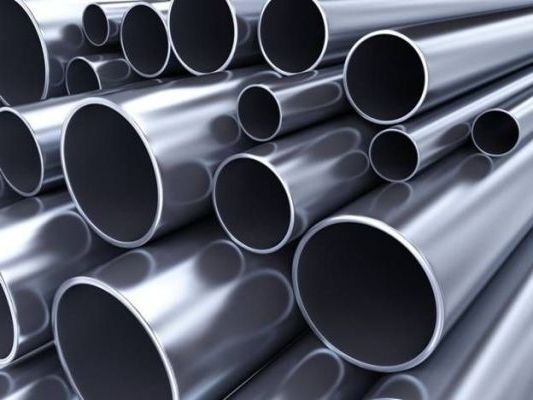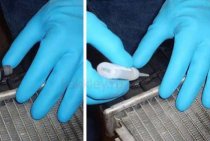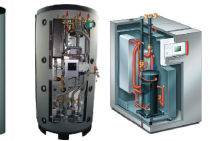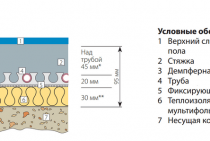DIY solid fuel boiler
Consider the example of the most popular boiler with upper combustion (Fig. 3). If necessary, the dimensions can be changed in proportion to those indicated in the drawing. A distinctive feature of the design is a pipe that serves as an air supply regulator and a heat exchanger at the same time. The gases released during the smoldering of the fuel rise up and ignite in the upper furnace.
For manufacturing, the materials described in section 2 are required: pipes, sheet steel, angle, insulation, asbestos cardboard, electrodes.
The first stage of a homemade boiler includes the following steps:
- A cylindrical body is welded from a pipe with a diameter of 45 cm and a length of 150 cm.
- The bottom is closed with a circle cut out of sheet steel by welding.
- In the pipe of the lower diameter (lower part), a rectangular hole is cut out under the ash pan door. It can also be made from steel sheet or purchased ready-to-size.
- The firebox is located in the upper part, a rectangle is also cut out under its door. The door must be insulated with asbestos cardboard and an asbestos cord around the perimeter. All doors must be closed with latches.
- A smoke outlet is welded from a profile pipe, which will be inserted into the chimney.
Important! Moisture (condensate) will form on the surface of the pipe due to temperature differences, leading to corrosion, so the welds must be of high quality
- Legs from an equal angle are welded to the boiler body.
- Cut out the top cover with a diameter of 46 cm, which will be put on top of the cylindrical body.
DIY heat exchanger for a solid fuel boiler
The second stage is the production of a heat exchanger:
- A heat exchanger pipe with a diameter of 40 cm and a length of 130 cm is welded from a metal sheet.
- Insert it into a cylindrical body, fix a gap of 5 cm between the pipes, due to which a “water jacket” will form.
- The difference in the length of the pipes of the heat exchanger and the outer must be at least 20cm. The pipe in the pipe is fixed by welding using prepared metal rings.
- Branch pipes are installed in the upper and lower zones of the water jacket: one for supply, the other for the outlet of the coolant. For their manufacture, a pipe with a diameter of 5 cm is used, a thread is screwed on the outside, through which they will be connected to the pipes of the heating system.
- The distribution pipe through which air will be supplied is welded from a metal of greater thickness than for the housing and heat exchanger (at least 5 mm with a diameter of 6 cm). The length of the pipe is made 10 cm less than the length of the heat exchanger pipe (120 cm).
Important! The distribution pipe is located in the zone of high temperatures and deforms and burns out over time, so metal with a thickness of 5 mm or more is used for its manufacture
- The pipe is inserted into the prepared disc with a prepared hole. A metal steel disc with a diameter of 38 cm is welded to the pipe.
- At least 4 corners are welded to the base of the disk, acting as an impeller.
- A valve for batch air supply is installed to the upper part of the pipe and a loop is welded on which a chain is fixed to lift the pipe.
Attention! To improve heat transfer, a forced air fan is installed in the upper part of the pipe.
How to properly assemble the boiler
After completing the two main stages, proceed to the final one.
The third stage is the assembly of the boiler:
- They choose the installation location of the boiler, check the level so that there are no drops that could impair the operation of the heat generator.
- The cover with the distribution pipe is pulled onto the body, having previously laid the asbestos cord. The cover can also be welded to the body.
- The flue pipe is inserted into the chimney.
- Through the outlet threaded pipes, the boiler is connected to the heating system of the house.
- The system is filled with water and the operation of the boiler is checked when it is not fully loaded.
- If the test went well, the boiler is loaded at full capacity.
Varieties of boilers
All existing solid fuel boilers can be divided into 3 groups:
There are a number of other classifying features, but it is the principle of fuel combustion that is decisive when choosing a boiler.
Pyrolysis
In boilers of this type, fuel burns slowly with minimal air access, due to which the amount of combustible gas increases and, when it is burned again, the efficiency of the boiler rises to 85-90%. And although some people think that it is very difficult to make such a boiler with their own hands, we will tell and, most importantly, show how to make a long-burning pyrolysis solid fuel boiler with our own hands (see drawings below).
Photo 1 Scheme of the pyrolysis boiler on wood
Classical
Structurally, this is a standard wooden stove, where, due to the smaller size of the combustion chamber, the fuel burns out a little more slowly. As a rule, it is these boilers that they prefer to make on their own. You will also learn how to make such a classic unit in the article.
Photo 2 Scheme of a classic long-burning boiler
The design of such boilers is remarkable not only for ease of manufacture, but also for the possibility of connecting a second circuit to produce hot water simultaneously with heating.
These are the most efficient boilers, the efficiency of which approaches 95%. The main advantage is in a fully automatic process, where the pellets loaded into the hopper are poured into the combustion chamber by means of an auger. The complex design and automation make it difficult to manufacture independently.
Photo 3 Scheme of a solid fuel boiler with automatic pellet feed
Fuel types
Today, solid fuels on the Russian market are presented in a large assortment. This:
- firewood, including euro (compressed coniferous or hardwood sawdust),
- granulated bio-pellets (compressed sawdust, peat, agricultural waste, etc.);
- coal - all varieties and fractions of stone and anthracite;
- woodworking and agricultural waste.
In order for heating to be cost-effective, it is recommended to purchase or manufacture a universal boiler that can operate on any type of fuel.
If you decide to purchase such equipment, pay attention to combined heating boilers. that run on alternative fuels, and switching is very fast and easy
These may be the following options:
- electric combos;
- solid fuel combos;
- universal, using any combination of fuel.
Design and principle of operation
The principle of operation of such a boiler is relatively simple - cold air is drawn in from below, passing through the walls of the chamber, it heats up, rises and heats the room.
Photo 4 We make a boiler from improvised materials
In long-burning boilers, unlike traditional ones, air access should be as limited as possible. In order to increase the duration of combustion and reduce the amount of free space in the combustion chamber, it is necessary to load the fuel as much and densely as possible.
Required materials and tools:
- pipe 0.3-0.5 cm;
- metal sheet 0.5-0.8 mm;
- metal corners;
- fittings;
- pipe with a diameter of 25 cm (you can use an empty gas cylinder);
- welding machine and electrodes;
- Bulgarian;
Simple boiler of long burning blueprint
On fig. 1 shows a drawing of a simple boiler with a lower furnace. For the manufacture of a rectangular body and a heat exchanger, mild steel sheet is used. The heat exchanger is designed as a "water jacket".The heat transfer coefficient (COP) is increased due to the design of protrusions inside the boiler, reflecting the flame and heating gas.
Rice. 1 Boiler with "water jacket"
On fig. 2 shows a combined water jacket type heat exchanger (2) formed around the combustion chamber plus a slot register (3) made of steel sheet. The combustion products exit through the flue pipe (1). Solid fuel (5) burns in the lower part of the chamber. Below it is the air regulator (8).
Rice. 2 Slot register boiler
Top burning boiler
The drawing of the camera is shown in Fig.3. The cylinder-shaped boiler is made from pipes of different diameters. Air is supplied through a moving pipe that extends upwards to release the firebox when fuel needs to be loaded. When burned, it begins to decrease in volume and with it the pipe also falls smoothly down under the weight of its weight. Uniform fuel supply is achieved using a disk welded to the base of the pipe.
The heat exchanger is designed as a "water jacket" enveloping the combustion chamber. Air heating occurs in the upper part of the boiler.
Rice. 3. Boiler with top combustion
Choosing the type of solid fuel boiler
How to understand which boiler will be optimal for servicing a particular heating system? Obviously, it is necessary to determine the type of fuel, the required power of the unit and the features of its design, the installation process and subsequent operation, as well as the features of the connected heating system.
Among the materials that can be used as solid fuels, the most widely used are:
- coal;
- peat briquettes;
- pellets;
- firewood;
- sawdust and other combustible production waste.
Types of solid fuel for heating boilers in the photo
In order to increase the profitability and efficiency of the heating system, it is possible to manufacture a universal unit that can work with various types of fuel.
The choice of the type and design of the heating boiler directly depends on what kind of fuel you are going to use, the required performance of the heating system, as well as the place where it will be installed. The following modifications of solid fuel heating units are suitable for self-production:
Equipped with a steel or cast iron heat exchanger, they can be used for both heating and hot water supply. The efficiency of such boilers is about 85%.
- Pyrolysis
They provide separate combustion of fuel and the volatile gases emitted at the same time, due to which the efficiency and, consequently, the economy of the heating system are significantly increased.
- Pellet
The efficiency of this type of heating boilers reaches 90%. Their main advantage is a high degree of automation of work processes, and the disadvantage is the complexity of the design.
- long burning
They are able to work continuously throughout the entire heating season, requiring fuel to be loaded once every few days, which distinguishes them favorably from classic solid fuel boilers.
The principle of operation of solid fuel boilers and their device
Solid organic fuel is the most ancient source of energy for humanity. To refuse it completely, even in the modern world, is impossible. Moreover, in addition to firewood and coal, many other types of combustible solids have appeared today:
- peat briquettes - dried and pressed peat releases a lot of heat during combustion;
- briquettes from woodworking waste - compressed sawdust, shavings and tree bark;
- birch charcoal - the same as for the barbecue;
- recycled garbage from landfills;
- fuel heating pellets - fine fuel obtained by pressing sawdust. Can be fed automatically
- ordinary dry sawdust.
Various raw materials for use in solid fuel boilers
It is clear that all this fuel is obtained by processing various wastes, which solves the problem of recycling at enterprises and goes in line with the "green" economy.
Useful advice! The most affordable fuel listed above is sawdust. If you intend to use them for heating, make sure they have less than 20% humidity. Large values of this parameter will not allow pyrolysis gas to be produced, since most of the heating energy will go to dry the fuel.
As a result of human activity, a huge amount of waste is generated that can be converted into high-energy fuel, which led to the appearance on the market of long-burning solid fuel heating boilers. Unlike conventional furnaces, these units do not work on the combustion of the fuel itself, but on its splitting as a result of heating. In the working chamber of such boilers, gaseous decomposition products of solid fuels are burned. Such a scheme of operation is several times more efficient than conventional fossil fuel combustion. Pyrolysis gas gives off a large amount of energy.
The principle of operation of a solid fuel boiler for long burning
The device of such a gas generator installation is not very complicated. You can even build a long-burning solid fuel boiler with your own hands. The drawing of the simplest version looks like this:
- a closed cylindrical tank, which has a hatch for laying fuel, a blower and a hole for installing a chimney;
- an air distributor is located inside the tank, which creates a swirl of the pyrolysis gas. It is attached to a movable telescopic tube. This whole structure, similar to a piston, presses on the fuel from above. The combustion of gas occurs above the piston, and the fuel smolders below it;
- the heat exchanger is built into the upper chamber where the maximum temperature is reached.
Slow smoldering of solid fuel occurs in the lower chamber. It is achieved by adjusting the air supply to the blower. The released gas burns intensively in the upper chamber and heats the coolant.
Scheme of the heating system of a private house using a solid fuel boiler
Useful advice! Do not use the simplest design for the manufacture of a boiler that will heat a residential building on an ongoing basis. To do this, you need to either purchase a finished product, or make a more complex and reliable version.
Long-burning solid fuel boilers can be indispensable in private homes, outbuildings, garages and greenhouses. They will be especially beneficial where there is a large wood processing industry, since waste at such enterprises is given away almost free of charge. These units are also needed in areas where there are regular interruptions in gas supply. Such installations have many advantages, but there is also one important drawback - a very high cost. That is why today it is important to make do-it-yourself solid fuel boilers for long burning. Drawings for this can be used with varying degrees of complexity. It depends on the skill level.
Do-it-yourself water heating of a private house, design schemes. Pros and cons. The difference between natural and forced water circulation.
The principle of operation of the long-burning boiler
In conventional solid fuel units, one bookmark is enough for 6-7 hours of burning. Accordingly, if the next portion of resources is not added to the furnace, the temperature in the room will immediately begin to decrease. This is due to the fact that the main heat in the room circulates according to the principle of free movement of gas. When heated by the flame, the air rises and exits.
The thermal resource of a long-burning boiler is enough for about 1-2 days from one laying of firewood. Some models can keep warm up to 7 days.
How is this cost-effectiveness and efficiency achieved?
Boiler operation scheme
From a conventional boiler, a TT long-burning boiler is distinguished by the presence of two combustion chambers at once. In the first, the fuel itself burns as standard, and in the second, the gases released during this process.
An important role in this process is played by the timely supply of oxygen, which is provided by the fan.
This principle has been implemented relatively recently. In 2000, the Lithuanian company Stropuva presented this technology for the first time, which immediately gained respect and popularity.
Homemade long-burning boiler
Today, this is the cheapest and most practical way to heat a country house, where gasification is not provided and there are power outages.
Such units operate on the principle of burning top fuel. As a standard, in all furnaces, the firebox is located at the bottom, which allows you to take cold air from the floor, heat it up and lift it up.
The principle of operation of this boiler is somewhat similar to pyrolysis. The main heat here is released not from the combustion of solid fuel, but from the gases released as a result of this process.
The combustion process itself takes place in a closed space. Through a telescopic pipe, the released gas enters the second chamber, where it is completely burned and mixed with cold air, which is pumped up by the fan.
TT long-burning boiler (diagram)
This is a continuous process that occurs until the fuel burns out completely. The temperature during such combustion is reached very high - about 1200 degrees.
As mentioned above, this boiler has two chambers: the main one is large and small. The fuel itself is placed in a large chamber. Its volume can reach 500 cubic meters.
Any solid fuel can act as a resource for combustion: sawdust, coal, firewood, pallets.
A constant air supply is carried out by a built-in fan. The advantage of this method is that solid fuel is consumed extremely slowly.
This significantly increases the efficiency of such a heater. Why does firewood burn out so slowly compared to a standard stove?
The bottom line is that only the top layer burns out, since air is blown by a fan from above. Moreover, the fan adds air only after the top layer has completely burned out.
There are many models on the market today that work on the same principle, but, depending on the dimensions, material of execution, additional options, have different efficiency and economy.
Universal TT boilers operate on absolutely any fuel, which will greatly simplify their operation for the owners. A more budget option is a wood-fired TT long-burning boiler. It works exclusively on wood and cannot be loaded with any other fuel option.
Useful tips for making a TT boiler
Alloy Steel Pipe for Boiler
You can significantly reduce the cost of building a unit if you take a seamless steel pipe of grade 20.
Before installing the boiler in the place determined for this unit, carry out the first kindling on the street, equipping the boiler with a temporary chimney. So you will be convinced of the reliability of the design and see if the case is assembled correctly.
If you use a gas cylinder as the main chamber, then keep in mind that such a unit will provide you with combustion for 10-12 hours due to the small amount of fuel being put in. So the small volume of the propane tank will decrease after cutting off the lid and ash pan. To increase the volume and ensure a longer burning time, two cylinders must be used. Then the volume of the combustion chamber will definitely be enough to heat a large room, and there will be no need to lay firewood every 4-5 hours.
In order for the ash pan door to close tightly, preventing air from entering, it must be well sealed. To do this, lay an asbestos cord around the perimeter of the door.
If you will make an additional door in the boiler, which allows you to “reload” the fuel without removing the cover, it must also be tightly sealed with an asbestos cord.
For the operation of a TT boiler, the diagram of which we attach below, any solid fuel is suitable:
- hard and brown coal;
- anthracite;
- firewood;
- wood pellets;
- briquettes;
- sawdust;
- shale with peat.
There are no special instructions for the quality of fuel - any will do. But keep in mind that with a high moisture content of the fuel, the boiler will not give a high efficiency.
How to make a solid fuel long-burning boiler with your own hands drawings and diagrams
Before you start manufacturing the boiler, you need to decide on its design. Its choice depends on the purpose of the unit. If it is intended for heating a small utility room, garage or country house, then it is not necessary to make a water circuit in it. Heating of such a room will occur directly from the surface of the boiler, by convection of air masses in the room, as from a furnace. For greater efficiency, you can arrange forced air blowing of the unit with a fan. If there is a liquid heating system in the room, it is necessary to provide a device in the circuit boiler in the form of a coil from a pipe or other similar structure.
Scheme for connecting a solid fuel boiler to a heating system
The choice of option also depends on the type of solid fuel that will need to be used. For heating with ordinary firewood, an increased volume of the furnace is required, and for the use of small fuel pellets, you can arrange a special container from which pelleted fuel is fed into the boiler automatically. For the manufacture of a solid fuel long-burning boiler with your own hands, the drawing can be taken and universal. It is suitable for any type of solid fuel used.
Drawing of a solid fuel boiler for long burning with a power of 25/30/40 kW
We will tell you step by step how and from what parts it is possible to make a long-burning solid fuel heating boiler according to the proposed scheme:
- prepare a place where the future unit will be installed. The base on which it will stand must be even, strong, rigid and fireproof. A concrete foundation or a thick cast-iron or steel slab is best suited for this. The walls must also be upholstered with refractory material if they are wooden;
- we collect all the necessary material and tools: of which we need an apparatus for electric arc welding, a grinder and a tape measure. From materials: sheet 4 mm steel; 300 mm steel pipe with 3 mm walls, as well as other pipes 60 and 100 mm in diameter;
- in order to make a long-burning solid fuel boiler, you need to cut a piece 1 m long from a large 300 mm pipe. It can be a little less if necessary;
- from a steel sheet we cut out the bottom along the diameter of the pipe and weld it, providing it with legs from a channel up to 10 cm long;
- the air distributor is made in the form of a circle made of steel sheet with a diameter 20 mm smaller than the pipe. An impeller from a corner with a shelf size of 50 mm is welded into the lower part of the circle. To do this, you can use a channel of the same size;
- from above, in the middle of the distributor, we weld a 60 - mm pipe, which should be higher than the boiler. In the middle of the distributor disk, we cut a hole through the pipe, so that there is a through tunnel. It is needed for air supply. A damper cuts into the upper part of the pipe, which will allow you to adjust the air supply;
Schematic representation of a solid fuel boiler device
- in the lowest part of the boiler we make a small door, equipped with a valve and hinges, leading to the ash pan for easy removal of ash. From above in the boiler we cut a hole for the chimney and weld a 100 mm pipe into this place. At first, it goes at a slight angle to the side and up by 40 cm, and then strictly vertically upwards. The passage of the chimney through the ceiling of the room must be protected according to fire safety rules;
- we finish the construction of a heating boiler for long-burning solid fuel by making the top cover. There must be a hole in the center for the air flow distributor pipe. The fit to the walls of the boiler must be very tight, excluding the ingress of air.
Drawing with dimensions for creating a solid fuel boiler with your own hands
Useful advice! To ignite a self-made, long-burning solid fuel boiler, the drawing of which was presented above, you must: remove the lid and raise the regulator, fill the boiler with fuel to the top and pour flammable liquid over it, put everything in place and throw the burning splinter into the regulator pipe . When the fuel flares up, reduce the air flow to a minimum so that it only begins to smolder. After that, the pyrolysis gas will ignite and the boiler will start.
